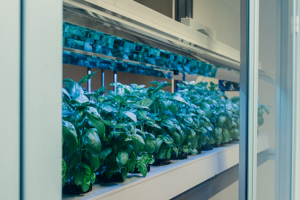
by Joshua Krause
With California’s water crisis in full swing, there is one question on the tip of everyone’s tongue. How do we save more water? More specifically, how do we cut back on the water we use to grow our food? This question has implications beyond the current drought. Even if there weren’t water shortages popping up all over the world right now, it would still become a problem at some point down the line.
The amount of fresh water on the Earth’s surface at any given time is finite, and having a growing population means we need to innovate. We’ve got to figure out how to grow more than we currently are, with the same amount of water. Space is also an issue. When the population grows you have two options. Cram people into already congested cities, or increase the farming capacity of our arable land. The former doesn’t sound very attractive (in my humble opinion), and our current farming methods seem to have reached their limits.
Vertical farming and hydroponics appear to be the best solutions, though they’re still in their infancy. They still have a lot of room for improvement before they become widely adopted. Fortunately, there are inventors like Mattias Lepp on the case, and he has an idea for bringing fresh produce to your home in a way that is even better than vertical farming in the city. How about fresh produce that can be grown inside your apartment?
Mattias Lepp says at least part of the answer involves making it easier for anyone—even city dwellers—to farm their own food. That’s why Lepp, founder of the Estonian startup Click & Grow, has developed what he calls a Smart Farm, an indoor farming system that requires 95 percent less water than traditional agriculture.
You may remember Click & Grow from their uber-successful Smart Herb Garden Kickstarter campaign a few years back. That product let people easily grow herbs in their homes with minimal maintenance. The Smart Farm is similar, but on a much larger scale. The system, which Lepp spent years developing in partnership with universities across Estonia, France, and Russia, can hold 50 to 250 plants at a time, making it a viable option for urban areas that don’t have access to fresh produce—areas the US government calls food deserts. Ideally, a shift to urban farming could drastically reduce the distance between where food is grown and where it is consumed.
The market for these indoor farms, or so-called vertical farms, is already fast-growing, driven by the growing realization that the current water-chugging agricultural system is unsustainable. On one end of the spectrum, countless DIY indoor farming enthusiasts are growing small gardens in their homes. On the other are professional outfits like Green Sense Farms out of Chicago, which grows leafy greens indoors and sells them at local stores. Even tech giants likePanasonic and Toshiba have begun developing gigantic de facto farms of their own in Asia, where there is a severe shortage of agricultural land.
His proposed device is about the size of an armoire, and will cost $1,500. While pricey, it’s still significantly smaller and less expensive than a traditional hydroponic system. It’s also a lot less complicated for new users, and employs various sensors to take the guesswork out of growing. Each plant has an LED light which tells you when it needs watering and nutrients, and you’ll be able to remotely take care of your plants with an app.
As for the 95% water efficiency, that is achieved by the inventors unique “smart soil” which is a spongy material that always keeps moisture evenly distributed, and maintains a level pH. This soil also releases its nutrients at different rates, according to the growth cycle of the plant.
I suspect that this technology may have the same trajectory as solar panels. For the longest time, most people thought the goal was to build sprawling solar farms in the desert, and pipe the energy into the cities.
But now we know that they’re far more economical when each home has its own solar panels. This invention may do the same thing for urban farming. Instead of making space for one large vertical farm in the downtown area of a city, it would be
And like solar panels, we can expect the price to go down with time. It’s safe to assume that much of the cost is due to the electronic components, which, just like everything else that’s electronic, will continue to get cheaper for the foreseeable future.
So if you live in an apartment, look out for the smart farm. Someday, we may all be able to grow at least some of our own food, no matter how small our homes are, and no matter how scarce our water is.
Joshua Krause was born and raised in the Bay Area. He is a writer and researcher focused on principles of self-sufficiency and liberty at Ready Nutrition. You can follow Joshua’s work at our Facebook page or on his personal Twitter.
Joshua’s website is Strange Danger























